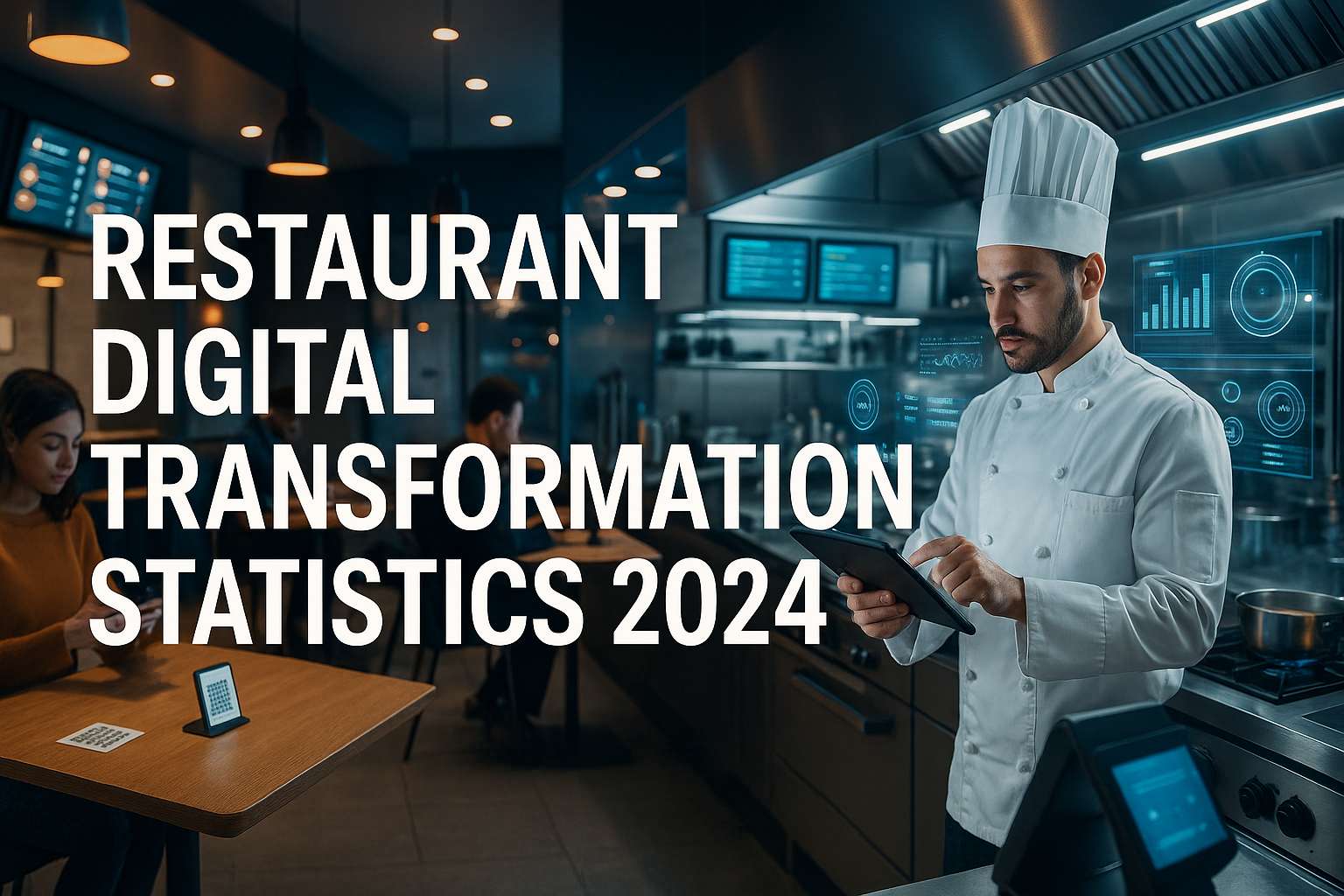The restaurant industry is experiencing an unprecedented digital revolution. As we analyze the latest data from 2024, one thing becomes crystal clear: technology is no longer optional for restaurant success—it's essential for survival and growth. This comprehensive analysis examines the most significant digital transformation statistics, trends, and insights that are reshaping how restaurants operate, serve customers, and compete in today's market.
From artificial intelligence-powered personalization to unified commerce platforms, restaurants are investing billions in technology solutions that promise to enhance customer experiences, streamline operations, and drive profitability. But what do the numbers really tell us about this digital transformation? Let's dive deep into the data that's defining the future of dining.
Executive Summary: The Digital Dining Revolution by the Numbers
The restaurant technology landscape has evolved dramatically, with market size projections that would have seemed impossible just a few years ago. Here are the headline statistics that frame our analysis:
•$59.3 billion: The global restaurant technology market size in 2024
•$314.85 billion: Projected market size by 2033 (16.39% CAGR)
•76%: Percentage of restaurant operators who believe technology gives them a competitive advantage
•33%: US restaurants planning to implement AI for personalized marketing in 2024
•Only 13%: Operators who are satisfied with their current technology stack
These numbers paint a picture of an industry in rapid transition, where the gap between technology adoption and satisfaction presents both challenges and opportunities for restaurant operators and technology providers alike.
The Current State of Restaurant Technology Adoption
Market Size and Growth Trajectory
The restaurant technology market has reached a pivotal moment in 2024. According to comprehensive industry reports, the global market hit $59.3 billion this year, representing a significant milestone in the industry's digital evolution. However, this figure is just the beginning of what promises to be explosive growth over the next decade.
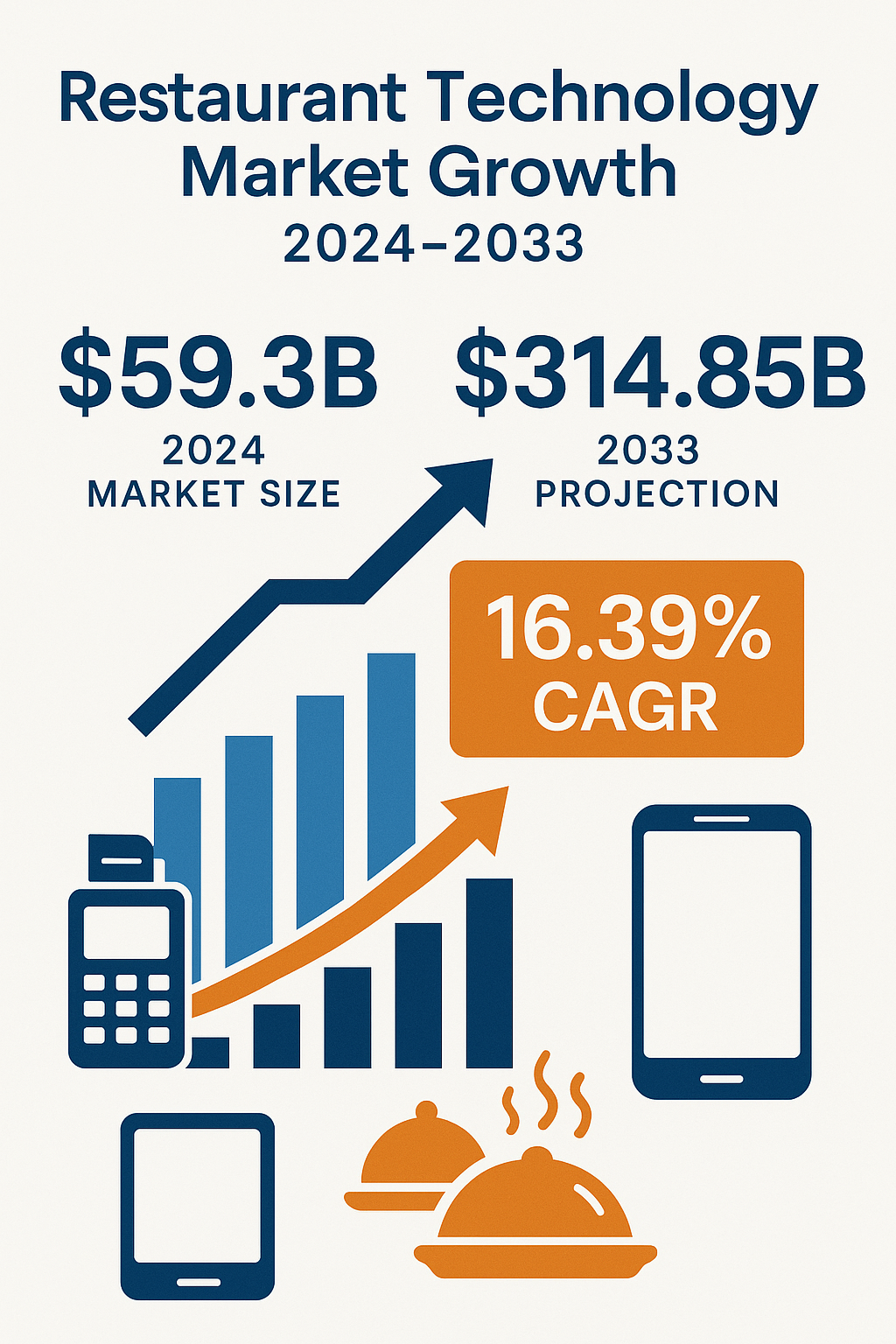
Projections indicate the market will reach $314.85 billion by 2033, representing a compound annual growth rate (CAGR) of 16.39% from 2023 to 2033. This growth rate significantly outpaces many other technology sectors and reflects the urgent need for restaurants to modernize their operations in response to changing consumer expectations and competitive pressures.
Breaking down the market by specific technology categories reveals interesting insights:
Point of Sale (POS) Systems: The global POS market is projected to reach $110.12 billion by 2032, with a CAGR of 16.1%. This growth is driven by the need for more sophisticated payment processing, integration capabilities, and real-time analytics.
Inventory Management Software: Expected to grow from $3.95 billion in 2024 to $9.17 billion by 2030, with a CAGR of nearly 15%. This segment's growth reflects restaurants' increasing focus on cost control and operational efficiency.
Digital Ordering Platforms: While specific market size data varies, the rapid adoption of mobile and online ordering systems represents one of the fastest-growing segments within restaurant technology.
The Competitive Advantage Imperative
Perhaps the most telling statistic about restaurant technology adoption comes from the National Restaurant Association's 2024 Technology Landscape Report: 76% of restaurant operators acknowledge that using technology gives them a competitive advantage. This near-consensus recognition marks a fundamental shift in how the industry views technology—from a nice-to-have luxury to a business necessity.
However, this widespread recognition of technology's importance doesn't translate to satisfaction with current solutions. Only 13% of operators report being happy with their existing technology stack, indicating a massive gap between aspiration and reality in restaurant technology implementation.
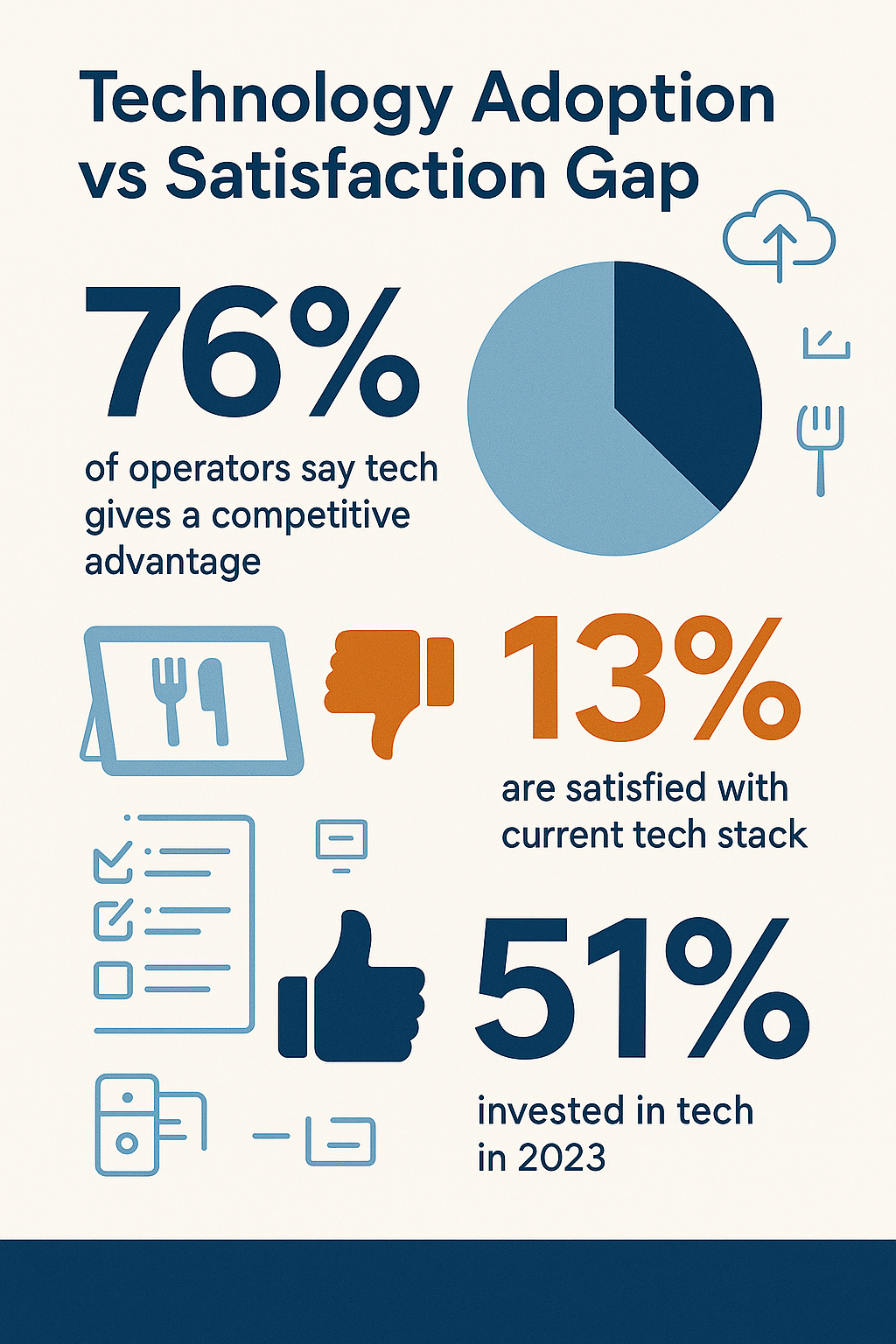
This dissatisfaction gap represents both a challenge and an opportunity:
For Restaurant Operators: The low satisfaction rate suggests that many current technology investments aren't delivering expected returns, either due to poor implementation, inadequate training, or misaligned solutions.
For Technology Providers: The gap between recognition of technology's importance and satisfaction with current solutions presents a significant market opportunity for companies that can deliver more effective, user-friendly solutions.
For the Industry: The statistics suggest that we're still in the early stages of restaurant technology maturation, with significant room for improvement and innovation.
Investment Patterns and Priorities
Technology Investment Trends
The data reveals clear patterns in how restaurants are prioritizing their technology investments in 2024. According to industry surveys, 51% of operators invested in technology in 2023 specifically to make their service more efficient, while 55% plan to continue investing in 2024.
The most significant investment priority for 2024 is digital and location-based marketing, with 63% of restaurants planning to devote resources to this area—making it the highest tech-related investment category. This focus on marketing technology reflects restaurants' recognition that attracting and retaining customers requires sophisticated digital engagement strategies.
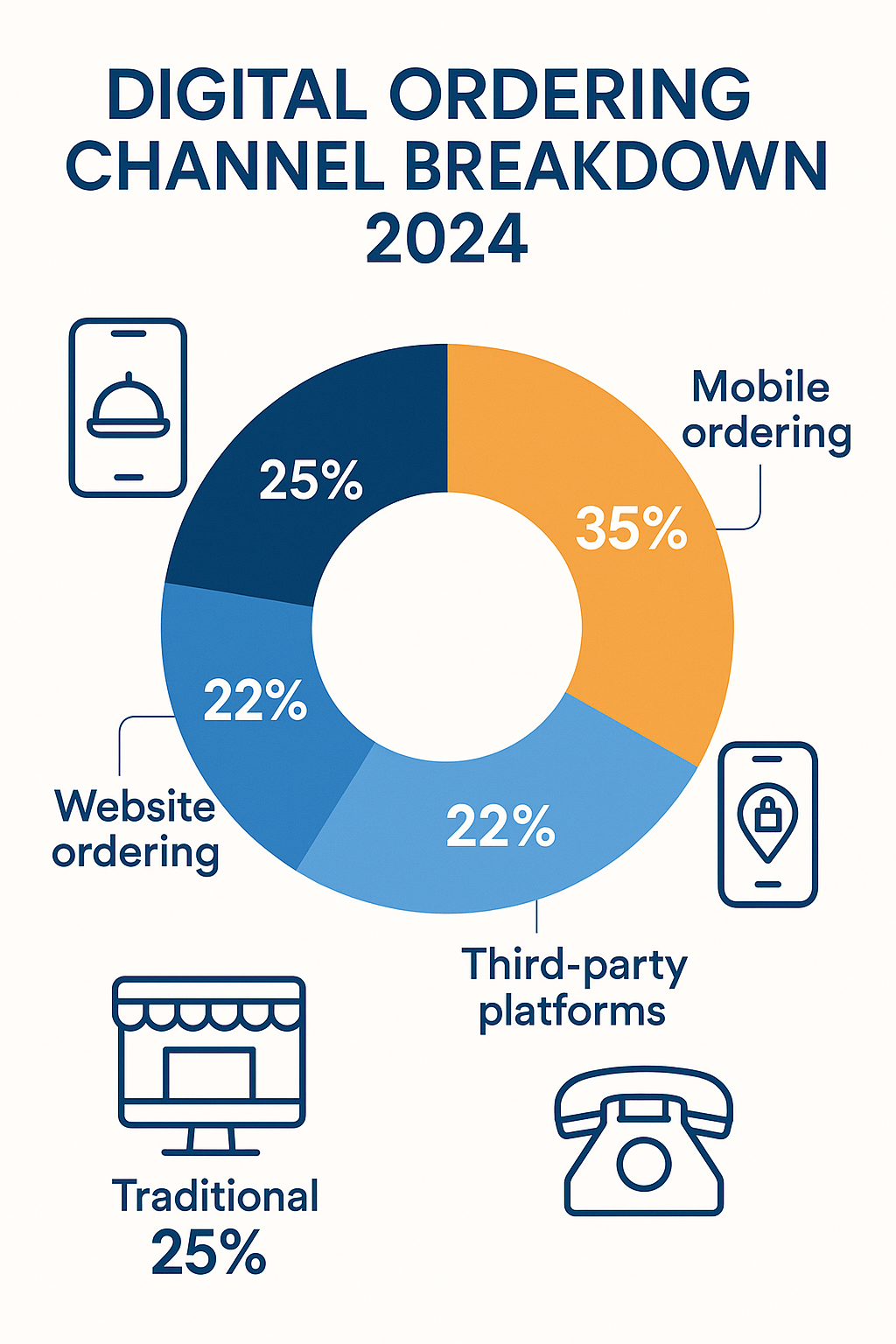
Other key investment priorities include:
Back Office Operations: 52% of operators plan to use technology for back office operations, including finance, compliance, tax, and payroll management. This represents a shift toward comprehensive operational digitization beyond customer-facing technologies.
Artificial Intelligence: 33% of US restaurants plan to begin using AI for personalized guest marketing in 2024, marking the mainstream emergence of AI in restaurant operations.
Staffing Optimization: Restaurants are increasingly investing in technology to optimize and automate staffing decisions, focusing on scheduling the right number and mix of employees for each shift.
The Efficiency Dividend
One of the most encouraging statistics for restaurant operators considering technology investments is the efficiency dividend that early adopters have already realized. According to industry data, 73% of restaurant operators have achieved higher operational productivity and efficiency than pre-pandemic levels, largely due to technological investments.
This efficiency gain is particularly significant given the challenging operating environment restaurants have faced in recent years, including labor shortages, supply chain disruptions, and changing consumer behaviors. The fact that technology has not only helped restaurants maintain operations but actually improve efficiency demonstrates the tangible value of digital transformation investments.
Consumer Behavior and Digital Ordering Trends
The Mobile-First Customer Revolution
Consumer behavior data from 2024 reveals a fundamental shift in how diners interact with restaurants. The statistics paint a clear picture of a mobile-first customer base that expects seamless digital experiences across all touchpoints.
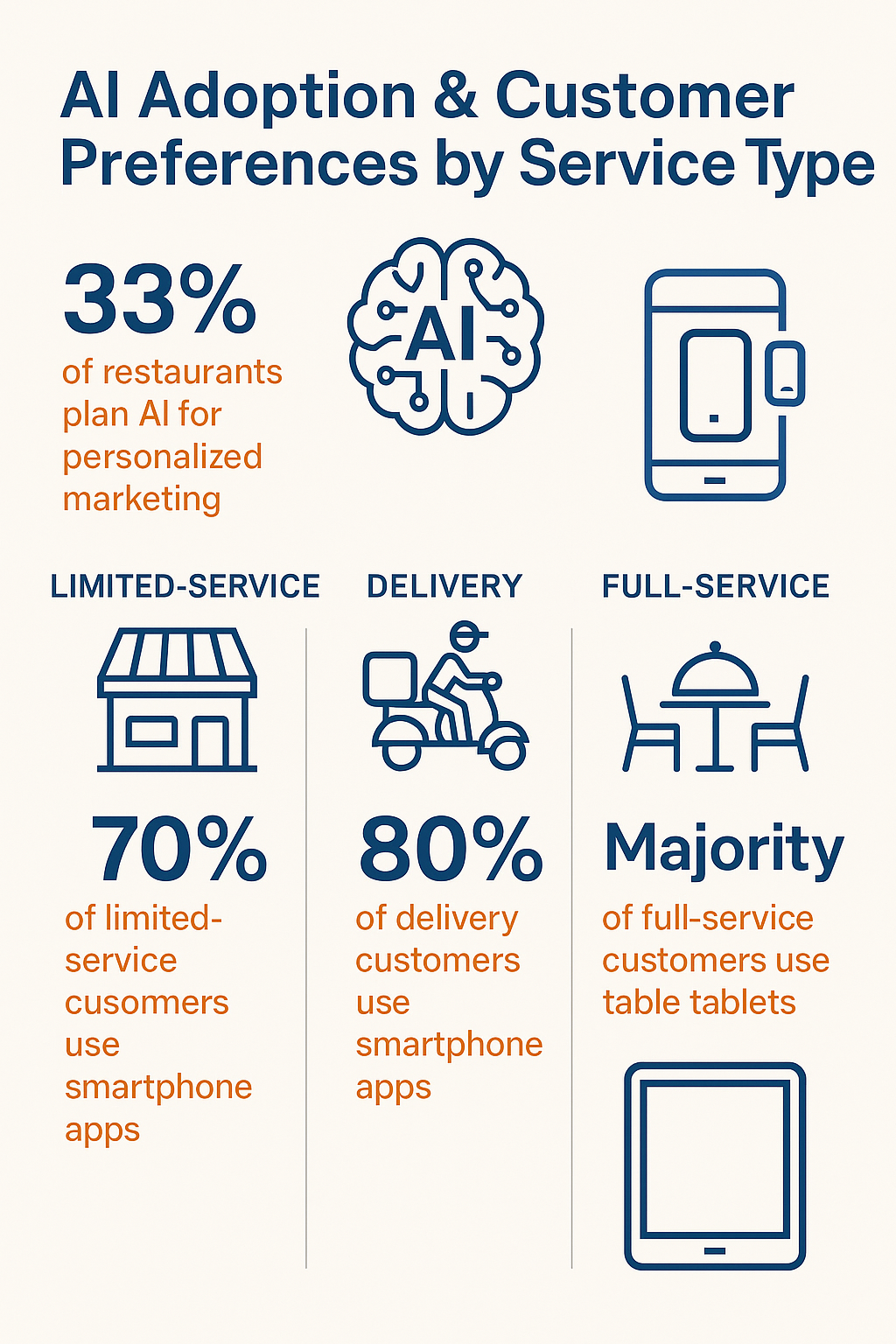
Digital Ordering Channel Distribution:
•Mobile ordering: 35% of all transactions
•Website ordering: 22% of transactions
•Third-party platforms: 18% of transactions
•Traditional phone/in-person: Remaining 25%
These numbers represent a dramatic shift from pre-pandemic ordering patterns and indicate that digital channels now account for the majority of restaurant transactions. The dominance of mobile ordering (35%) particularly highlights the importance of mobile-optimized experiences for restaurant success.
Service Segment Preferences
The National Restaurant Association's 2024 research reveals that consumer technology preferences vary significantly by service segment, providing valuable insights for operators in different restaurant categories:
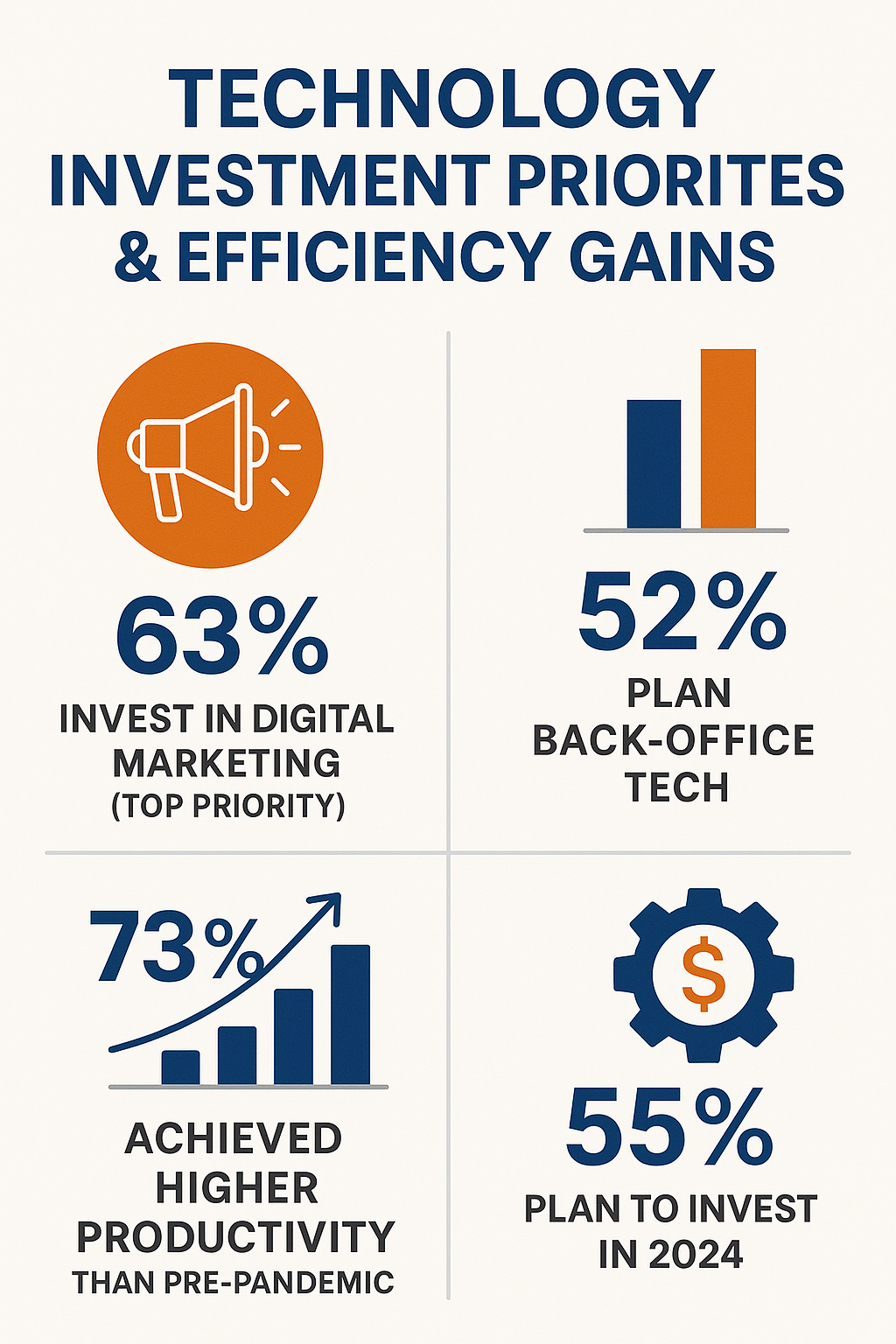
Limited-Service Restaurants:
•70% of customers would likely place an order using a smartphone app
•High preference for self-service kiosks and QR code ordering
•Strong adoption of loyalty programs integrated with mobile apps
•Emphasis on speed and convenience over personalized service
Full-Service Restaurants:
•Majority of customers would likely place an order or pay the check using a tablet at the table
•Preference for technology that enhances rather than replaces human interaction
•Interest in digital wine lists and menu customization options
•Appreciation for technology that reduces wait times without diminishing service quality
Delivery-Focused Operations:
•80% of customers would order delivery using a smartphone app
•High expectations for real-time order tracking
•Strong preference for integrated payment and tipping options
•Demand for accurate delivery time estimates and communication
The Deal-Seeking Digital Diner
One of the most significant consumer behavior insights from 2024 is the prevalence of deal-seeking behavior among digital diners. According to the National Restaurant Association's data, 7 in 10 adults look for deals when ordering takeout, delivery, or dining in restaurants.
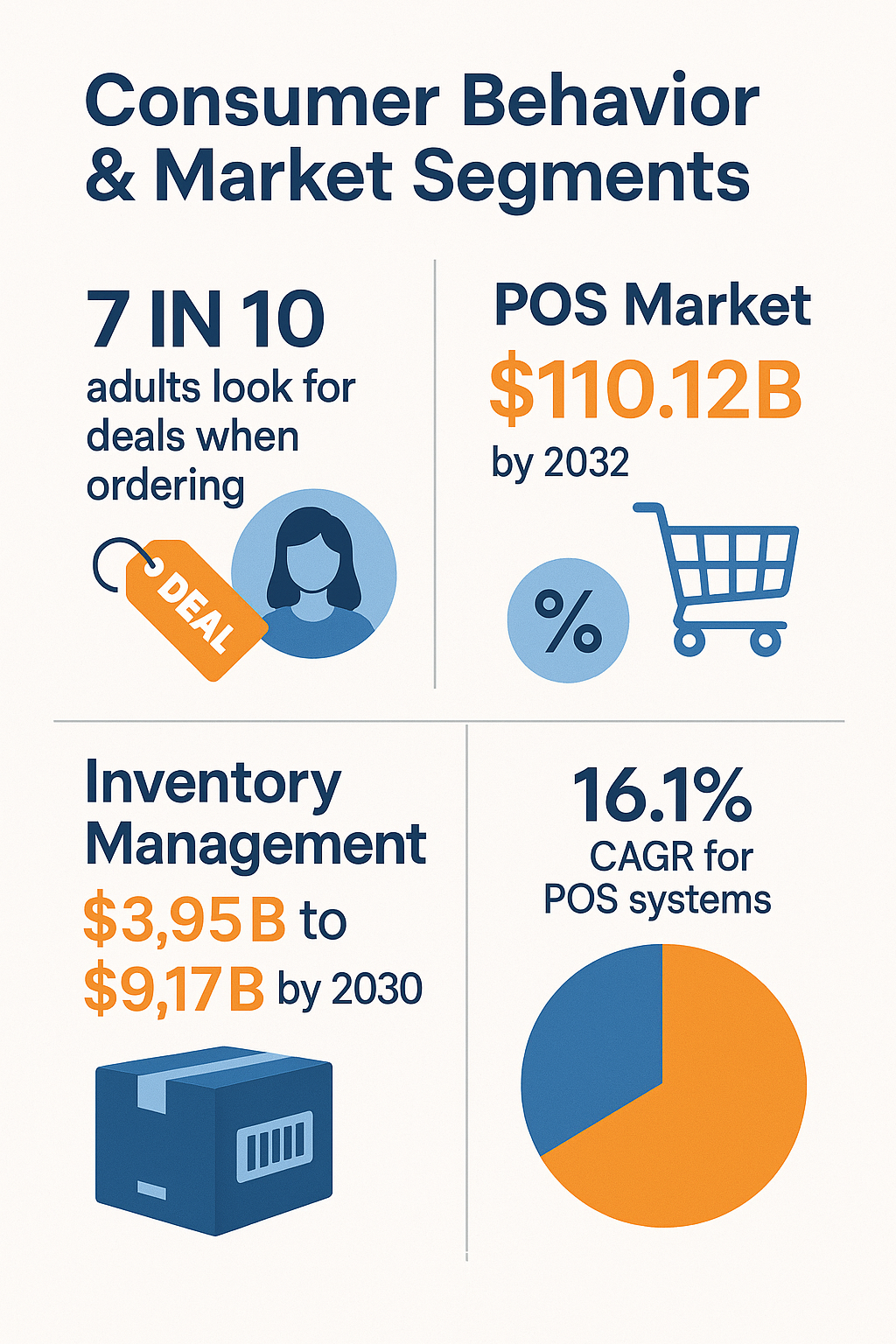
This statistic has profound implications for restaurant technology strategy:
Dynamic Pricing Opportunities: Restaurants with sophisticated technology platforms can implement dynamic pricing strategies, offering targeted promotions based on demand patterns, inventory levels, and customer behavior.
Loyalty Program Integration: The deal-seeking behavior creates opportunities for restaurants to drive repeat business through technology-enabled loyalty programs that offer personalized promotions and rewards.
Data-Driven Marketing: Restaurants can leverage customer data to create targeted promotional campaigns that appeal to price-conscious consumers while maintaining profitability.
Artificial Intelligence and Personalization
The AI Adoption Wave
Artificial intelligence represents one of the most significant emerging trends in restaurant technology for 2024. The statistic that 33% of US restaurants plan to begin using AI for personalized guest marketing represents a tipping point for AI adoption in the industry.
This level of AI adoption is particularly noteworthy because it represents mainstream acceptance rather than experimental implementation. When one-third of an industry commits to adopting a new technology within a single year, it signals a fundamental shift in operational strategy.
Current AI Applications in Restaurants:
Personalized Marketing: AI algorithms analyze customer ordering history, preferences, and behavior patterns to create targeted marketing campaigns and personalized menu recommendations.
Demand Forecasting: Machine learning models help restaurants predict busy periods, optimize inventory levels, and improve staff scheduling accuracy.
Dynamic Pricing: AI-powered systems adjust menu prices in real-time based on demand, inventory levels, and competitive factors.
Customer Service: Chatbots and virtual assistants handle routine customer inquiries, reservation management, and order modifications.
Menu Optimization: AI analyzes sales data, customer feedback, and market trends to recommend menu changes and new item introductions.
The Personalization Imperative
The focus on AI-powered personalization reflects a broader trend toward customer-centric technology strategies. Restaurants are recognizing that generic, one-size-fits-all approaches are no longer sufficient in a competitive market where consumers have numerous dining options.
Personalization technology enables restaurants to:
Increase Average Order Value: By recommending items based on customer preferences and ordering history, restaurants can encourage customers to try new items or add complementary products.
Improve Customer Retention: Personalized experiences create stronger emotional connections between customers and restaurants, leading to increased loyalty and repeat visits.
Optimize Marketing Spend: Targeted, personalized marketing campaigns typically achieve higher conversion rates and better return on investment compared to broad-based promotional efforts.
Enhance Customer Satisfaction: When restaurants demonstrate understanding of individual customer preferences, it creates a more satisfying and memorable dining experience.
Operational Technology and Efficiency Gains
Back-Office Digital Transformation
While customer-facing technologies often receive the most attention, 2024 data reveals significant investment in back-office operational technologies. The statistic that 52% of operators plan to use technology for back office operations—including finance, compliance, tax, and payroll—indicates a comprehensive approach to digital transformation.
This back-office focus represents a maturation of restaurant technology strategy. Early technology adoption often concentrated on customer-facing solutions like POS systems and online ordering. Now, restaurants are recognizing that operational efficiency requires technology integration across all business functions.
Key Back-Office Technology Areas:
Financial Management: Automated accounting systems, real-time financial reporting, and integrated payment processing reduce manual work and improve accuracy.
Compliance and Reporting: Technology solutions help restaurants manage complex regulatory requirements, from food safety documentation to labor law compliance.
Supply Chain Management: Digital platforms streamline vendor relationships, automate ordering processes, and provide real-time inventory visibility.
Human Resources: Technology platforms manage employee scheduling, payroll processing, performance tracking, and training programs.
The Productivity Paradox Resolution
The restaurant industry has historically struggled with productivity improvements, often referred to as the "productivity paradox" where technology investments don't translate to measurable efficiency gains. However, 2024 data suggests this paradox may finally be resolving.
The statistic that 73% of restaurant operators have achieved higher operational productivity and efficiency than pre-pandemic levels, largely due to technological investments, represents a significant breakthrough. This productivity improvement is particularly impressive given the challenging operating environment of recent years.
Factors Contributing to Productivity Gains:
Integration and Automation: Modern restaurant technology platforms integrate multiple functions, reducing manual data entry and eliminating redundant processes.
Real-Time Analytics: Operators can make data-driven decisions quickly, optimizing everything from staffing levels to menu pricing based on current performance metrics.
Streamlined Communication: Technology platforms improve communication between front-of-house and back-of-house operations, reducing errors and improving service speed.
Predictive Capabilities: AI and machine learning help restaurants anticipate demand, optimize inventory, and schedule staff more effectively.
Technology Challenges and Satisfaction Gaps
The Implementation Reality Check
Despite widespread recognition of technology's importance and significant investment levels, the restaurant industry faces substantial challenges in technology implementation and satisfaction. The stark statistic that only 13% of operators are happy with their existing technology stack reveals the complexity of successful restaurant technology deployment.
This low satisfaction rate suggests several underlying issues:
Integration Challenges: Many restaurants operate with multiple technology solutions that don't communicate effectively with each other, creating operational inefficiencies and data silos.
Training and Adoption: Technology solutions often fail to deliver expected benefits because staff aren't adequately trained or motivated to use them effectively.
Vendor Relationships: Poor vendor support, inadequate customization, and misaligned expectations contribute to technology dissatisfaction.
ROI Measurement: Many restaurants struggle to measure the return on investment from technology implementations, making it difficult to optimize their technology strategies.
The Path to Technology Success
The gap between technology investment and satisfaction presents both challenges and opportunities for the restaurant industry. Successful technology implementation requires a strategic approach that goes beyond simply purchasing software or hardware.
Best Practices for Technology Success:
Comprehensive Planning: Restaurants need to develop clear technology strategies that align with business objectives and operational requirements.
Staff Engagement: Successful technology implementation requires buy-in from all levels of staff, from management to front-line employees.
Vendor Partnership: Choosing technology vendors based on long-term partnership potential rather than just features or price often leads to better outcomes.
Continuous Optimization: Technology implementation is an ongoing process that requires regular evaluation, training, and adjustment.
Data-Driven Decision Making: Restaurants should establish clear metrics for measuring technology success and use data to guide optimization efforts.
Emerging Technologies Reshaping Restaurant Operations
Beyond Traditional POS: The Unified Commerce Revolution
The restaurant technology landscape is evolving beyond traditional point-of-sale systems toward comprehensive unified commerce platforms. These integrated solutions combine payment processing, inventory management, customer relationship management, and analytics into cohesive ecosystems that provide restaurants with unprecedented operational visibility and control.
Key Components of Unified Commerce Platforms:
Omnichannel Integration: Customers can seamlessly transition between in-store, online, and mobile experiences without losing order history, preferences, or loyalty benefits.
Real-Time Data Synchronization: Inventory levels, menu availability, and pricing updates instantly across all channels, preventing overselling and ensuring consistency.
Centralized Customer Profiles: Unified platforms create comprehensive customer profiles that track interactions across all touchpoints, enabling personalized experiences regardless of how customers engage with the restaurant.
Integrated Analytics: Rather than managing separate reporting systems for different functions, unified platforms provide holistic business intelligence that reveals insights across all operations.
Contactless Technology and QR Code Innovation
The pandemic accelerated adoption of contactless technologies, but 2024 data shows these solutions have evolved far beyond basic safety measures to become sophisticated customer engagement tools.
QR Code Ordering Systems have emerged as a particularly successful technology category, offering benefits that extend well beyond contactless interaction:
Reduced Labor Costs: QR code ordering can reduce the need for order-taking staff, allowing restaurants to reallocate human resources to food preparation and customer service.
Increased Order Accuracy: Digital ordering eliminates miscommunication between customers and staff, reducing order errors and improving customer satisfaction.
Upselling Opportunities: Digital menus can dynamically suggest add-ons, upgrades, and complementary items based on customer selections and preferences.
Data Collection: QR code systems capture detailed customer ordering data that can inform menu optimization, pricing strategies, and marketing campaigns.
Voice Technology and Conversational Commerce
While still in early adoption phases, voice technology represents an emerging frontier in restaurant technology. Early implementations focus on drive-through optimization and phone order automation, but the potential applications extend much further.
Current Voice Technology Applications:
Drive-Through Automation: AI-powered voice systems can handle routine drive-through orders, reducing wait times and freeing staff for more complex tasks.
Phone Order Processing: Automated systems can handle simple phone orders, take reservations, and provide basic information about hours and menu items.
Kitchen Communication: Voice-activated systems help kitchen staff manage orders, communicate with front-of-house teams, and access recipe information hands-free.
Future Voice Technology Potential:
Smart Speaker Integration: Customers could place orders through home smart speakers, with restaurants integrating into existing voice ecosystems.
Multilingual Support: Voice systems could provide seamless service in multiple languages, expanding restaurants' potential customer base.
Accessibility Enhancement: Voice technology can make restaurant services more accessible to customers with visual impairments or mobility limitations.
Future Outlook and Industry Predictions
Technology Investment Projections
The robust growth projections for restaurant technology—from $59.3 billion in 2024 to $314.85 billion by 2033—reflect not just market expansion but fundamental changes in how restaurants operate. This growth trajectory suggests several key trends that will shape the industry's future.
Investment Priority Evolution:
2024-2026: Focus on AI implementation, unified commerce platforms, and customer personalization technologies.
2027-2029: Emphasis on advanced automation, predictive analytics, and integrated supply chain technologies.
2030-2033: Adoption of emerging technologies like augmented reality, advanced robotics, and IoT-enabled smart restaurant systems.
The Integration Imperative
Future restaurant technology success will depend heavily on integration capabilities. The current dissatisfaction with existing technology stacks (only 13% satisfaction rate) largely stems from fragmented systems that don't communicate effectively.
Future Integration Requirements:
API-First Architecture: Restaurant technology platforms will need to provide robust APIs that enable seamless integration with other systems.
Data Standardization: Industry-wide data standards will emerge to facilitate better integration between different technology providers.
Cloud-Native Solutions: Cloud-based platforms will become the standard, enabling better scalability, integration, and real-time data sharing.
Sustainability and Technology Convergence
Environmental sustainability is becoming increasingly important to restaurant operations, and technology will play a crucial role in helping restaurants reduce their environmental impact while maintaining profitability.
Sustainability Technology Applications:
Waste Reduction: AI-powered systems will optimize inventory management and demand forecasting to minimize food waste.
Energy Efficiency: Smart building technologies will optimize energy usage in restaurant facilities, reducing costs and environmental impact.
Supply Chain Optimization: Technology platforms will help restaurants source ingredients more sustainably and reduce transportation-related emissions.
Digital-First Operations: Continued digitization will reduce paper usage and streamline operations to minimize environmental impact.
Conclusion: Navigating the Digital Transformation Journey
The restaurant industry's digital transformation in 2024 represents both unprecedented opportunity and significant challenge. The statistics reveal an industry that recognizes technology's critical importance—with 76% of operators acknowledging its competitive advantage—yet struggles with implementation satisfaction, with only 13% happy with their current technology stack.
This gap between recognition and satisfaction defines the current moment in restaurant technology evolution. Success in this environment requires more than simply adopting the latest technologies; it demands strategic thinking, careful implementation, and ongoing optimization.
Key Takeaways for Restaurant Operators:
1.Technology is Essential, Not Optional: The $59.3 billion market size and projected growth to $314.85 billion by 2033 reflect technology's fundamental role in restaurant success.
2.Customer Expectations Drive Adoption: With 70% of limited-service customers willing to use smartphone apps and 80% of delivery customers preferring app-based ordering, customer preferences are clear.
3.Integration Matters More Than Features: The low satisfaction rates suggest that successful technology implementation depends more on how well systems work together than on individual feature sets.
4.AI and Personalization Are Becoming Standard: With 33% of restaurants planning AI implementation for personalized marketing, these technologies are moving from experimental to essential.
5.Operational Efficiency Gains Are Real: The 73% of operators achieving higher productivity through technology investments proves that well-implemented technology delivers measurable benefits.
The restaurant industry's digital transformation journey is far from complete. The statistics from 2024 show an industry in transition, with massive investment, rapid adoption, and significant challenges. Success in this environment will belong to restaurants that approach technology strategically, prioritize integration and user experience, and remain focused on using technology to enhance rather than replace the fundamental hospitality that defines great restaurant experiences.
As we look toward 2025 and beyond, the restaurants that thrive will be those that successfully navigate the balance between technological innovation and human connection, using data and automation to create more personalized, efficient, and satisfying dining experiences for their customers.

